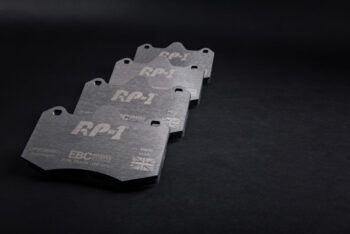EBC Brakes Racing’s two new track day/race pad compounds, RP-1™ and RP-X™, offer distinctly different response characteristics that allow the driver to tailor the ‘feel’ of the brakes to their individual preference, but which one should you choose?
In this article we explain the differences between the two materials so that you can make an informed choice between them, based on your own vehicle hardware and what type of response you prefer from your vehicles brake system.

RP-1™ boasts a flat friction response averaging 0.45mu and is capable of operating at temperatures of up to 7500C without brake fade. However, unlike many other track/race pad materials on the market, RP-1™ possesses a progressive/benign response characteristic that provides exception ‘feel’ during each and every braking event.
The slightly lower friction level of RP-1™ allows the brake pedal to be worked harder, which is particularly beneficial to cars that are over-servo’d from the factory (for example: Mk7 VW Golf GTI, BMW M cars, Audi RS models, etc).

On inherently over-servo’d vehicles, RP-1™ somewhat negates the effect of the over-servo’d brake system setup, resulting in a more progressive and smooth response when driven on track.
In some modern vehicles, it can sometimes feel as if all the braking happens in the first inch of pedal travel. Whilst this sharp sensation gives the impression that the car has very ‘good’ brakes to the average driver pootling down to the shops, experienced track/race drivers know that a hair-trigger brake response is undesirable, verging on totally unacceptable for smooth driving at the limit.
A modest amount of brake pedal travel is actually beneficial for performance driving and this is exactly what RP-1™ enables, encouraging the driver to find the limit under braking whilst also enabling trail-braking. RP-1™ is particularly suitable for non-ABS assisted vehicles, where a smooth response is essential to avoid locking a wheel under braking.

Similarly, many competitor (non-EBC) Big Brake Kits utilise calipers only available in one displacement/variety of piston sizes, which when paired with a larger brake disc with an increased torque arm radius may result in a similarly over-servo’d sensation.
This approach to designing BBKs is fine for dedicated track cars, where a different master cylinder and brake bias adjustor is usually employed, but can be problematic on road cars where the OE actuation system is retained. In such instances RP-1™ serves to remedy the over-servo’d sensation, restoring a more progressive and feelsome characteristic under braking.

RP-X™ also boasts a flat friction response and is capable of operating at temperatures of up to 8500C without brake fade, yet has a slightly higher average friction of 0.55mu. RP-X™’s higher friction level provides a stronger initial bite and more power under braking, all for a reduced pedal effort compared to RP-1™.
If you’ve experienced some of the leading track/race compounds from EBC’s competitors (such as Pagid RS29, Ferodo DS 1.11 or Endless ME20) then RP-X™ will feel very similar in its response characteristic. The higher friction level and higher initial bite mean RP-X™ is well suited to under-servo’d vehicles (for example: R35 Nissan GT-R and Porsche GT models).

On these inherently under-servo’d vehicles the brake system is naturally more progressive and feelsome, therefore a more aggressive pad material such as RP-X™ is preferable to keep pedal travel within the optimum displacement range. However, the extra power served up by RP-X™ isn’t at the expense of exceptional feel during the braking phase, with the material still allowing the driver to modulate the brake pedal with ease and explore the limits in each and every braking zone.

Similarly, dedicated track/race cars that employ aftermarket master cylinders, sway bars and bias adjusters would also be well suited to running RP-X™, since these components allow the driver to fine tune the brake bias to permit the use of a naturally more aggressive pad material.
Conclusion
Since both RP-1™ and RP-X™ have a flat friction response coupled with near identical fade resistance, it isn’t a case of one material being ‘better’ than the other. It’s more a case of the driver choosing what ‘feels best’ in their own opinion, whilst also factoring in any other modifications made to their vehicles brake system as explained above. That’s why EBC Racing offer both of these distinctly different materials, to give the customer choice to find what works for them.




